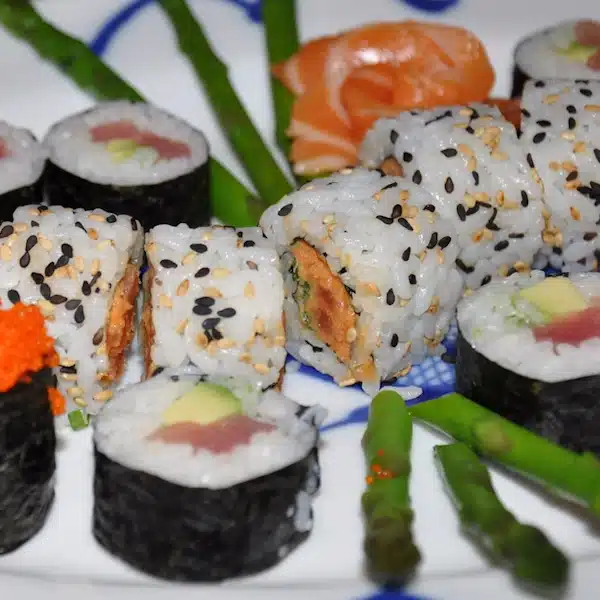The Growth of Sustainable Sushi

Sustainable sushi is an growing movement that addresses the critical need to balance our love for sushi with the sustainability of our seafood supply. Over-fishing has threatened many species, and guides are now available to help consumers make environmentally responsible choices.
These guides often list fish by both their English and Japanese names, helping sushi lovers identify which species are endangered. By asking whether the sushi they consume was caught or farmed, diners can make informed decisions that support ocean conservation.
The Environmental Defense Fund’s Guide For Sustainability
The Environmental Defense Fund (EDF) offers a guide that focuses on both the health of the oceans and the consumer. This guide, for instance, highlights Bluefin Tuna as a species to avoid due to over-fishing, which has caused its population to plummet by 90% in the past 30 years.
Other fish to avoid include farmed arctic char, red snapper, freshwater eel, and monkfish. By steering clear of these species, consumers can help protect the ocean’s biodiversity and their own health.
Driving Change: Sushi Chefs and Restaurants
The goal is to encourage more sushi chefs and restaurants to adopt ocean-friendly practices. Americans have a deep love for sushi but often overlook the sustainability of the fish they consume. While many seafood restaurants have embraced sustainable practices, the sushi industry has been slower to respond.
The EDF guide stands out by providing comprehensive information, including the health benefits of various fish. It advocates for the use of locally produced fish and a reduction in the use of endangered species. The push for sustainability is gradually gaining traction, but there is still much work to be done.
Online Resources: Empowering Consumers
In addition to pocket guides, online resources such as the our Sustainable Sushi Guide offer valuable information on sustainable sushi choices. Our guide and other resources aim to raise awareness about environmental conservation and promote ocean-friendly dining practices.
The rise of environmental consciousness has spurred the growth of the sustainable sushi movement, highlighting the importance of making informed choices for the health of our oceans.
The Challenge of Changing Conditions
One challenge with sustainable sushi guides is the ever-changing conditions of ocean ecosystems. A fish deemed safe to eat today might become endangered tomorrow. To address this, guide promoters have set up websites to provide real-time updates and inform the public about new additions to the “do not eat” list.
For example, while farmed salmon currently has the green light, Bluefin Tuna remains in critical condition, and consumers are urged to avoid it.
The Omega-3 Boom and Over-fishing
The popularity of sushi has soared, partly due to the discovery of Omega-3 fatty acids in fish, which offer numerous health benefits. However, this surge in demand has led to over-fishing, depleting many fish populations.
While most seafood restaurants have adapted to serve sustainable fish, sushi restaurants have been more resistant. Despite this, there are numerous alternatives to endangered species like Bluefin Tuna, such as Yellowfin Tuna, which can still provide delicious and sustainable sushi options.
Consumer Awareness and Demand
Environmental awareness is on the rise, and consumers are increasingly demanding that the products and services they consume are environmentally responsible. The choices we make today will impact future generations.
If we don’t take action now, we risk losing beloved species and the traditional sushi experience. Education is the first step in addressing over-fishing and promoting sustainable sushi. By choosing alternative fish and supporting sustainable practices, we can ensure that sushi remains a delicious and viable option for generations to come.
The Critical Role of Restaurants
Restaurants play a crucial role in this movement. By understanding the importance of sustainability and making informed choices about the fish they serve, they can help preserve ocean biodiversity. Educating yourself about sustainable sushi options is vital. By reading guides and staying informed, you can make choices that support conservation efforts. Together, we can halt over-fishing and protect our oceans.
Ensuring a Future for Sushi
The sustainable sushi movement is about more than just preserving fish populations; it’s about ensuring that future generations can enjoy sushi as we do today. By making responsible choices and supporting sustainable practices, we can enjoy sushi without compromising the health of our oceans.
Explore sustainable sushi guides and make informed choices the next time you dine out. Future generations depend on the choices we make today. If we aren’t careful there may not be sushi as we know it for our children and their children.
Unless we conserve the resources we have now, we will all suffer. If the Bluefin tuna and other species of fish were given time to recoup from their losses recovery is not out of the question. It is time that restaurants are made to understand the criticality of this issue. Educating yourself is the first step in helping address this situation.
We need to halt the over fishing of many species of fish and animals. There are many alternate choices the sushi industry can make as there are other types of fish that are just as good. We can all agree that sushi is delicious and worth saving. Let’s do what we can to make sure it can be enjoyed by future generations as well. a href=”/sushi-sashimi-info/sustainable-sushi-making-the-right-choices/” target=”_blank” rel=”noopener canonical”>Our guide to sustainable sushi should be helpful in your decision-making, or find one of the many available to learn about out what you should and should not order next time you go out for fish or sushi. It all begins with you. After all, the future of sushi is in our hands.
Meshiagare!
I have always been fascinated by the creation and culture of different foods, particularly sushi and sashimi in the modern era of Japanese cuisine. I am a classically trained chef and sushi connoisseur, also having operated a food service company and enjoy investigating and experimenting with food around the world.
